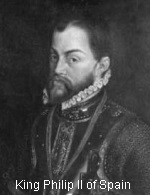|







| |
The Spaniards as Colonial Masters
 Spain
reigned over the Philippines for
333 years, from 1565 to 1898. since Spain was far from the country, the Spanish king
ruled the Islands through the viceroy of Mexico, which was then another Spanish colony.
When Mexico regained its freedom in 1821, the Spanish king ruled the Philippines through
a governor general. A special government body that oversaw matters, pertaining to the
colonies assisted the king in this respect. This body became known by many names.
Council of the Indies (1565-1837), Overseas Council (1837-1863), and Ministry of the
Colonies (1863–1898). It is implemented the decrees and legal codes Spain
promulgated although many of its provisions could not apply to condition in the
colonies. It also exercised legislative and judicial powers. Spain
reigned over the Philippines for
333 years, from 1565 to 1898. since Spain was far from the country, the Spanish king
ruled the Islands through the viceroy of Mexico, which was then another Spanish colony.
When Mexico regained its freedom in 1821, the Spanish king ruled the Philippines through
a governor general. A special government body that oversaw matters, pertaining to the
colonies assisted the king in this respect. This body became known by many names.
Council of the Indies (1565-1837), Overseas Council (1837-1863), and Ministry of the
Colonies (1863–1898). It is implemented the decrees and legal codes Spain
promulgated although many of its provisions could not apply to condition in the
colonies. It also exercised legislative and judicial powers.
The Political Structure
Spain established a centralized colonial government in the
Philippines that was
composed of a national government and the local governments that administered
provinces, cities, towns and municipalities. With the cooperation of the local
governments the national government maintained peace and order, collected taxes
and built schools and other public works.
The Governor General
As the King's representative and the highest-ranking official in the Philippines,
the governor general saw to it that royal decrees and laws emanating from Spain
were implemented in the Philippines. He had the power to appoint and dismiss
public officials, except those personally chosen by the King. He also supervised
all government offices and the collection of taxes.
The governor general exercised certain legislative powers, as well. He issued
proclamations to facilitate the implementation of laws.
The Residencia
This was a special judicial court that investigates the performance of a
governor general who was about to be replaced. The residencia, of which the
incoming governor general was usually a member, submitted a report of its
findings to the King.
The Visita
The Council of the Indies in Spain sent a government official called the
Vistador General to observe conditions in the colony. The Visitador General
reported his findings directly to the King.
The Royal Audiencia
Apart from its judicial functions, the Royal Audiencia served
as an advisory body to the Governor General and had the power to check and a report on his abuses.
The Audiencia also audited the expenditures of the colonial government and sent a
yearly report to Spain. The Archbishop and other government officials could also
report the abuses of the colonial government to be Spanish king. Despite all these
checks, however, an abusive governor general often managed to escape stiff fines,
suspension, or dismissal by simply bribing the Visitador and other investigators.
The Provincial Government
The Spaniards created local government units to facilitate the country’s
administration. There were two types of local government units – the alcadia and
the corregimiento. The alcadia, led by the alcalde mayor, governed the provinces
that had been fully subjugated: the corregimiento, headed by corregidor,
governed the provinces that were not yet entirely under Spanish control. The
alcalde mayors represented the Spanish king and the governor general in their
respective provinces. They managed the day-to-day operations of the provincial
government, implemented laws and supervised the collection of taxes. Through
they were paid a small salary, they enjoyed privileges such as the indulto de
comercio, or the right to participate in the galleon trade.
The Municipal Government
Each province was divided into several towns or pueblos headed by
Gobernadordcillos, whose main concerns were efficient governance and tax
collection. Four lieutenants aided the Governardorcillo: the Teniente Mayor
(chief lieutenant), the Teniente de Policia (police lieutenant), the Teniente de
Sementeras (lieutenant of the fields) and the Teniente de Ganados (lieutenant of
the livestock).
The Encomienda System
Spain owed the colonization of the Philippines to Miguel Lopez de Legazpi, who
valiantly and loyally served the Spanish crown. To hasten the subjugation of the
country,
King Philip II instructed
Legazpi to divide the Philippines into large territories called encomiendas, to
be left to the management of designated encomenderos.
To show
his gratitude to his conquistadors, the King made them the first encomenderos in
the colony. As the King’s representatives in their respective encomiendas, the
encomenderos had the right to collect taxes. However, the encomiendas were not
there to own. The encomenderos were only territorial overseers who had the
duty to: 1) protect the people in the encomienda; (2) maintain peace and order;
(3) promote education and health programs; and (4) help the missionaries
propagate Christianity. Continue to
The Galleon Trade.
Back to Philippine History - Home Page
|